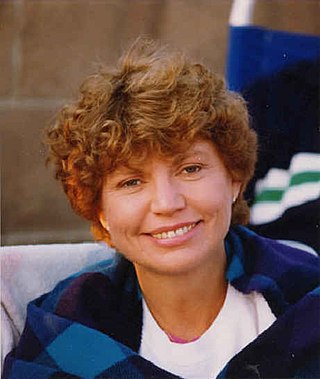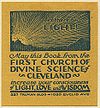Deism is the philosophical position and rationalistic theology that generally rejects revelation as a source of divine knowledge and asserts that empirical reason and observation of the natural world are exclusively logical, reliable, and sufficient to determine the existence of a Supreme Being as the creator of the universe. More simply stated, Deism is the belief in the existence of God, solely based on rational thought without any reliance on revealed religions or religious authority. Deism emphasizes the concept of natural theology—that is, God's existence is revealed through nature.
Feminist theology is a movement found in several religions, including Buddhism, Hinduism, Sikhism, Neopaganism, Baháʼí Faith, Judaism, Islam, Christianity and New Thought, to reconsider the traditions, practices, scriptures, and theologies of those religions from a feminist perspective. Some of the goals of feminist theology include increasing the role of women among clergy and religious authorities, reinterpreting patriarchal (male-dominated) imagery and language about God, determining women's place in relation to career and motherhood, studying images of women in the religions' sacred texts, and matriarchal religion.

Christian Science is a set of beliefs and practices which are associated with members of the Church of Christ, Scientist. Adherents are commonly known as Christian Scientists or students of Christian Science, and the church is sometimes informally known as the Christian Science church. It was founded in 19th-century New England by Mary Baker Eddy, who wrote the 1875 book Science and Health with Key to the Scriptures, which outlined the theology of Christian Science. The book became Christian Science's central text, along with the Bible, and by 2001 had sold over nine million copies.
Transcendentalism is a philosophical, spiritual, and literary movement that developed in the late 1820s and 1830s in the New England region of the United States. A core belief is in the inherent goodness of people and nature, and while society and its institutions have corrupted the purity of the individual, people are at their best when truly "self-reliant" and independent. Transcendentalists saw divine experience inherent in the everyday, rather than believing in a distant heaven. Transcendentalists saw physical and spiritual phenomena as part of dynamic processes rather than discrete entities.

The Religious Science movement, or Science of Mind, was established in 1926 by Ernest Holmes and is a spiritual, philosophical and metaphysical religious movement within the New Thought movement. In general, the term "Science of Mind" applies to the teachings, while the term "Religious Science" applies to the organizations. However, adherents often use the terms interchangeably.

Elizabeth Clare Prophet was an American spiritual leader, author, orator, and writer. In 1963 she married Mark L. Prophet, who had founded The Summit Lighthouse in 1958. Mark and Elizabeth had four children. Elizabeth, after her second husband's death on February 26, 1973, assumed control of The Summit Lighthouse.
The New Thought movement is a new religious movement that coalesced in the United States in the early 19th century. New Thought was seen by its adherents as succeeding "ancient thought", accumulated wisdom and philosophy from a variety of origins, such as Ancient Greek, Roman, Egyptian, Chinese, Taoist, Vedic, Hindu, and Buddhist cultures and their related belief systems, primarily regarding the interaction among thought, belief, consciousness in the human mind, and the effects of these within and beyond the human mind. Though no direct line of transmission is traceable, many adherents to New Thought in the 19th and 20th centuries claimed to be direct descendants of those systems.

Josephine Emma Curtis Hopkins was an American spiritual teacher and leader. She was involved in organizing the New Thought movement and was a theologian, teacher, writer, feminist, mystic, and healer; who taught and ordained hundreds of people, including notably many women. Hopkins was called the "teacher of teachers" and "mother of New Thought" because a number of her students went on to found their own churches or to become prominent in the New Thought Movement, including Charles and Myrtle Fillmore, founders of Unity Church; Ernest Holmes; and H. Emilie Cady, author of Unity's cornerstone text Lessons in Truth. According to Charles S. Braden, Hopkins influenced the development of New Thought "more than any other single teacher", and modern scholars have identified Hopkins as the founder of New Thought.

Charles Sherlock Fillmore was an American religious leader who founded Unity, a church within the New Thought movement, with his wife, Myrtle Page Fillmore, in 1889. He became known as an American mystic for his contributions to spiritual interpretations of Biblical Scripture. Fillmore promoted vegetarianism for three decades of his life.

Joseph Denis Murphy was an Irish author and New Thought minister, ordained in Divine Science and Religious Science.

Harriet Emilie Cady was an American homeopathic physician and author of New Thought spiritual writings. Her 1896 book Lessons in Truth: A Course of Twelve Lessons in Practical Christianity is now considered one of the core texts on Unity Church teachings. It is the most widely read book in that movement. It has sold over 1.6 million copies since its first publication, and has been translated into eleven languages and braille.

Another Gospel: Cults, Alternative Religions, and the New Age Movement is a non-fiction book discussing new religious movements and the New Age movement, written by Ruth A. Tucker. The book was published in 1989 by Zondervan, a Christian publishing house. Another edition was released by the same publisher in 2004.

Malinda Elliott Cramer was a founder of the Church of Divine Science, a healer, and an important figure in the early New Thought movement.

Nona Lovell Brooks, described as a "prophet of modern mystical Christianity", was a leader in the New Thought movement and a founder of the Church of Divine Science.
Affirmative prayer is a form of prayer or a metaphysical technique that is focused on a positive outcome rather than a negative situation. For instance, a person who is experiencing some form of illness would focus the prayer on the desired state of perfect health and affirm this desired intention "as if already happened" rather than identifying the illness and then asking God for help to eliminate it.

Horatio Willis Dresser was a New Thought religious leader and author in the United States. In 1919 he became a minister of General Convention of the Church of the New Jerusalem, and served briefly at a Swedenborgian church in Portland, Maine.
The history of New Thought started in the 1830s, with roots in the United States and England. As a spiritual movement with roots in metaphysical beliefs, New Thought has helped guide a variety of social changes throughout the 19th, 20th, and into the 21st centuries. Psychologist and philosopher William James labelled New Thought "the religion of healthy-mindedness" in his study on religion and science, The Varieties of Religious Experience.
The International Divine Science Association was founded in 1892 in San Francisco, California by religious leader and author Malinda Cramer. The association was "founded for the promulgation of Divine Science, the God idea of perfect unity, harmony and wholeness, associated together in a unity of spirit, for the healing of nations, and the general good of humanity."











